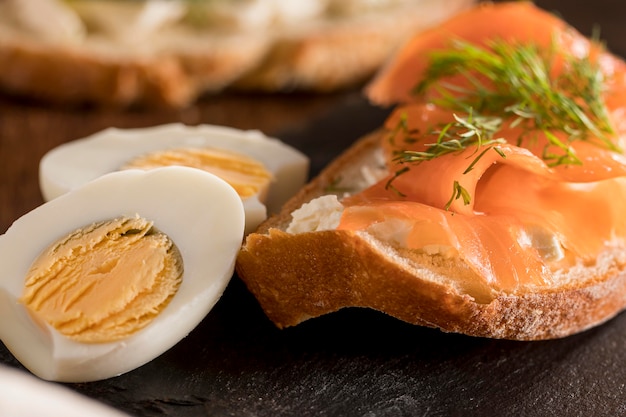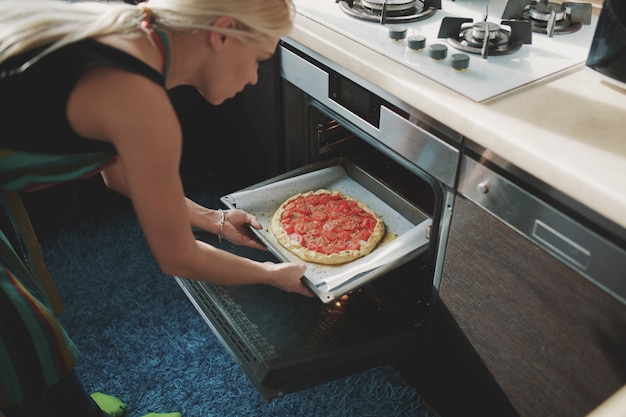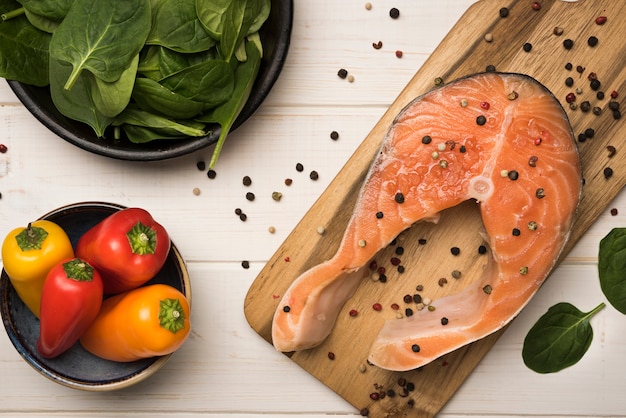(Part 1) The Salmon Selection: Picking the Perfect Fish

The first step on your salmon baking journey is picking the right fish. Supermarket shelves are often overflowing with choices, which can be overwhelming, but I’ll break it down for you. Here’s what you need to look for:
Freshness Matters
For the best results, go for fresh salmon. You can usually find it in the seafood section of your local supermarket. Look for fillets that are shiny and slightly iridescent, with no sign of dryness or discoloration. The flesh should be firm and springy to the touch, with a pleasant, slightly salty scent.
If you’re purchasing pre-packaged salmon, make sure the packaging is intact and the fish is properly sealed. Check the expiration date too - you want to ensure the salmon is as fresh as possible.
Wild vs. Farmed: A Matter of Choice
The wild vs. farmed debate is a big one, and it comes down to personal preference. I prefer wild salmon because it tends to have a richer flavour and texture. It's also often considered more sustainable since it's not raised in a controlled environment. However, farmed salmon is a great alternative, especially if you're on a budget. Just make sure the farmed salmon is sustainably sourced and ethically raised.
Look for labels that indicate sustainable practices, such as the Marine Stewardship Council (MSC) or Aquaculture Stewardship Council (ASC) certifications.
Picking the Right Cut
Salmon comes in different cuts, each with its own unique qualities. choosing the right cut depends on your preference and the recipe you plan on making. Here's a rundown of some common cuts:
- Fillet: This is the most popular cut, typically boneless and skin-on. It’s easy to handle and cooks evenly, making it perfect for baking.
- Steak: A thicker cut of salmon, great for grilling or baking. It offers a more substantial meal.
- Sides: These are smaller portions of the fillet, perfect for individual servings.
- Loin: A boneless cut with a bit more fat, offering a richer flavour. It’s a good choice if you prefer a more decadent salmon dish.
- Belly: This is the fatty, flavourful part of the salmon, often used for smoking or grilling. It's known for its buttery texture and intense flavour.
(Part 2) The Prep Work: Getting Ready for the Oven

Now that you’ve selected your salmon, let’s prep it for baking! This step is essential for achieving perfectly cooked salmon.
Pat It Dry
First things first, pat your salmon dry with paper towels. This helps the skin crisp up nicely in the oven and prevents the salmon from steaming, which can lead to a soggy texture.
Seasoning It Up
Seasoning is where you can truly express your culinary creativity! I’m a fan of keeping it simple with a sprinkle of salt and pepper, but you can get as fancy as you like.
Here are some other seasonings that pair beautifully with salmon:
- Garlic powder
- Paprika (sweet or smoked)
- Cayenne pepper (for a touch of heat)
- Herbs de Provence
- Dried dill
- Lemon zest
Remember, a little goes a long way! You don't want to overwhelm the delicate flavour of the salmon.
The Skin Dilemma
The age-old question: to skin or not to skin? It’s up to you. If you’re baking a whole salmon, it’s generally best to leave the skin on for extra protection. For fillets, you can remove the skin if you’d like.
Leaving the skin on helps to keep the salmon moist and adds a nice crispy texture. If you remove the skin, be sure to pat the flesh dry to avoid excess moisture.
Adding a Touch of Flavor
A squeeze of lemon or lime juice adds a refreshing citrusy flavour to your salmon. It also helps to brighten the dish and create a beautiful golden-brown crust. You can also add other flavour-enhancing ingredients like a drizzle of olive oil or a sprinkle of herbs.
(Part 3) The Baking Basics: A Simple Guide

We’re now at the heart of the baking process! This is where we transform raw salmon into a delectable meal. Don’t worry, it’s much simpler than it seems.
Preheating the Oven
Always preheat your oven to the correct temperature before putting your salmon in. This ensures even cooking and prevents the fish from becoming dry. Most recipes call for an oven temperature of 350°F (175°C), but be sure to check your specific recipe for the recommended temperature.
Choosing the Right Baking Dish
A baking dish is essential for baking salmon. It’s best to use a shallow dish, such as a roasting pan or a baking sheet, as this allows for even heat distribution. You can also use an oven-safe skillet or a baking dish with a lid for a more enclosed cooking environment.
If you're using a baking sheet, place the salmon on a rack to allow air circulation, which helps with even cooking and prevents the salmon from steaming.
Baking Time: The Golden Rule
Baking time for salmon can vary depending on the thickness of the fillets and your oven’s heat distribution. As a general guideline, allow 12-15 minutes per inch of thickness. For example, a 1-inch thick fillet would take around 12-15 minutes to cook.
However, it's always best to check for doneness, as ovens can vary in temperature and salmon thickness can be inconsistent.
Checking for Doneness
How do you know when your salmon is cooked to perfection? The key is to check for doneness. Use a fork or a toothpick to gently pierce the thickest part of the fish. If the flesh flakes easily and the inside is opaque (not translucent), it’s cooked through.
The internal temperature should reach 145°F (63°C). You can use a food thermometer to check the internal temperature if you want to be extra sure.
(Part 4) The Baking Time Table: A Quick Reference
To simplify things, I've created a handy baking time table for you, based on the thickness of the salmon fillets. This table provides a rough estimate of baking times. Always check the salmon for doneness to ensure it's cooked through.
| Thickness (Inches) | Baking Time (Minutes) |
|---|---|
| 1/2 | 6-8 |
| 1 | 12-15 |
| 1 1/2 | 18-22 |
| 2 | 24-28 |
(Part 5) Beyond the Basics: Adding Flavour and Texture
Now, let's talk about elevating your salmon baking game. We’ve discussed seasonings and citrus, but there's so much more you can do to add flavour and texture to your dish.
Herbs and Aromatics
Fresh herbs are a must-have for any salmon dish. I’m a huge fan of dill, parsley, chives, and thyme. Simply chop the herbs and sprinkle them over the salmon before baking. You can also add some aromatics like garlic or onions for an extra layer of flavour.
To enhance the flavour of your herbs, try toasting them in a dry skillet over medium heat for a few minutes before adding them to the salmon. This brings out their fragrance and adds a deeper, more complex flavour.
Vegetables: A Colourful Addition
Why not bake your salmon with some veggies? It's a delicious and convenient way to add colour and nutrition to your meal. Broccoli, asparagus, or zucchini are all great choices. Simply toss the veggies with olive oil, salt, and pepper, and bake them alongside the salmon.
You can also try roasting root vegetables, like carrots, potatoes, or sweet potatoes, with your salmon for a heartier dish.
A Creamy Topping
If you’re feeling fancy, you can top your salmon with a creamy sauce. A simple mixture of sour cream, cream cheese, and lemon juice is a classic choice. You can also get creative with a pesto sauce, a tomato salsa, or even a spicy sriracha mayo.
To make your creamy topping extra delicious, try incorporating fresh herbs or a touch of garlic. You can also use Greek yogurt instead of sour cream or cream cheese for a lighter and tangier flavour.
(Part 6) The Finishing Touches: Taking Your Salmon to the Next Level
We’re almost there! Just a few finishing touches to take your baked salmon from good to incredible.
A Final Blast of Heat
For a crispy skin and an extra layer of flavour, you can broil the salmon for the last few minutes of cooking. This creates a beautiful golden-brown crust. Just be careful not to overcook it!
To avoid burning the salmon, keep a close eye on it under the broiler. If the skin starts to brown too quickly, reduce the heat or move the salmon further away from the heating element.
Resting Time
Once your salmon is cooked, don’t rush to eat it! Let it rest for a few minutes before serving. This allows the juices to redistribute and makes the fish even more tender and flavourful.
The ideal resting time is 5-10 minutes. This gives the salmon a chance to relax and absorb the flavours you’ve added.
Presentation is Key
Don’t underestimate the power of presentation. A simple drizzle of olive oil and a sprinkle of chopped herbs can transform your baked salmon into a culinary masterpiece. Serve it alongside a side of rice, quinoa, or roasted vegetables for a complete meal.
Use a beautiful serving dish to elevate your salmon. You can also garnish it with lemon slices, capers, or fresh herbs to add colour and visual appeal.
(Part 7) A culinary adventure: Salmon Baking Beyond the Basics
Now that you’ve mastered the basics, let’s explore some creative ways to bake your salmon. These recipes are a bit more adventurous, but trust me, they’re worth the effort.
Honey Glazed Salmon: A Sweet and Savoury Delight
This dish is a perfect balance of sweet and savoury flavours. The honey glaze adds a touch of sweetness and a beautiful glossy finish.
Ingredients:
- 1 pound salmon fillets
- 1/4 cup honey
- 1 tablespoon soy sauce
- 1 tablespoon rice vinegar
- 1 tablespoon sesame oil
- 1 clove garlic, minced
- 1 teaspoon ginger, grated
- 1/2 teaspoon black pepper
Instructions:
- Preheat oven to 375°F (190°C).
- Combine honey, soy sauce, rice vinegar, sesame oil, garlic, ginger, and pepper in a small bowl.
- Place salmon fillets in a baking dish and pour the glaze over them.
- Bake for 15-20 minutes, or until the salmon is cooked through and the glaze is bubbly.
For a more intense flavour, you can brush the salmon with the glaze several times during the baking process. This helps the glaze caramelize and create a beautiful crust.
salmon en papillote: A Delightful Surprise
This elegant dish is a beautiful presentation. The salmon is baked in a parchment paper pouch, creating a delicious and aromatic steam that infuses the fish with flavour.
Ingredients:
- 1 pound salmon fillets
- 1/2 cup sliced cherry tomatoes
- 1/4 cup chopped red onion
- 1 tablespoon olive oil
- 1 tablespoon lemon juice
- 1 teaspoon dried oregano
- 1/2 teaspoon salt
- 1/4 teaspoon black pepper
Instructions:
- Preheat oven to 400°F (200°C).
- Cut four large pieces of parchment paper.
- Divide salmon fillets, cherry tomatoes, red onion, olive oil, lemon juice, oregano, salt, and pepper evenly among the parchment paper.
- Fold the parchment paper over the salmon and seal the edges tightly to create a pouch.
- Bake for 15-20 minutes, or until the salmon is cooked through.
You can experiment with different vegetables and seasonings for your salmon en papillote. For a touch of sweetness, try adding a few slices of pear or apple.
(Part 8) FAQs: Your Salmon Baking Questions Answered
Let’s tackle those burning questions you might have about baking salmon.
Q: What's the best way to prevent my salmon from sticking to the baking dish?
A: A simple trick is to lightly grease the baking dish with olive oil or butter. You can also line the dish with parchment paper for easy cleanup and to prevent sticking.
Q: Can I bake salmon with the skin on?
A: Absolutely! Baking salmon with the skin on helps to keep the fish moist and adds a nice crispy texture. Just make sure you score the skin with a knife to prevent it from curling up during cooking.
To score the skin, use a sharp knife to make diagonal cuts across the skin at about 1/2 inch intervals. This helps the fat to render out and prevents the skin from becoming too tough.
Q: How do I know if my salmon is overcooked?
A: overcooked salmon will be dry and flaky, with a whitish, opaque flesh. It's important to check for doneness regularly to avoid overcooking.
If you’re unsure, it’s better to err on the side of undercooking than overcooking. Salmon can be cooked slightly more in a warm oven or pan. However, overcooked salmon is difficult to salvage.
Q: Can I bake salmon from frozen?
A: Yes, you can bake salmon from frozen, but it will take longer. Just thaw the salmon in the refrigerator overnight or in cold water for a few hours before baking. Be sure to add a few extra minutes to the baking time.
If you’re short on time, you can also thaw the salmon in the microwave using the defrost setting. However, this method can sometimes result in uneven thawing and a slightly mushy texture.
Q: What can I do with leftover salmon?
A: Leftover salmon is perfect for salads, sandwiches, or even a delicious salmon salad. It can also be added to pasta dishes, soups, or stir-fries.
To store leftover salmon, refrigerate it in an airtight container for up to 3-4 days. You can also freeze leftover salmon for up to 2-3 months. Just be sure to thaw it thoroughly before using it in recipes.
Conclusion: A Salmon Baking Master
And there you have it, folks! You're now officially a salmon baking master. Remember, practice makes perfect, so don’t be afraid to experiment and find what works best for you. And if you're ever feeling lost, just remember this guide. I've got your back (and your taste buds) covered.
Happy baking, and enjoy your delicious salmon creations!
Everyone is watching

Corn on the Cob: The Ultimate Guide to Perfectly Cooked Ears
Healthy MealsAh, corn on the cob. Just the name evokes images of sunny days, barbecues, and that sweet, juicy flavour that ...

Scallops: The Ultimate Guide to Perfect Cooking
Healthy MealsAh, scallops. Those delicate, sweet, and utterly delicious morsels of the sea. They hold a special place in my...

Spaghetti Squash: The Ultimate Guide to Cooking and Serving
Healthy MealsRemember that time you saw spaghetti squash at the supermarket, looking all bumpy and strange, and thought, "W...

Salmon Cooking Times: Perfect Guide for Every Recipe
Healthy MealsLet me tell you, cooking salmon is an art form. It's all about getting that perfect balance: juicy and tender,...

Ham Cooking Time: How Long to Bake, Smoke, or Boil a Delicious Ham
Healthy MealsAh, ham. It's a classic, isn't it? A real crowd-pleaser, especially around holidays. And when done right, it'...
